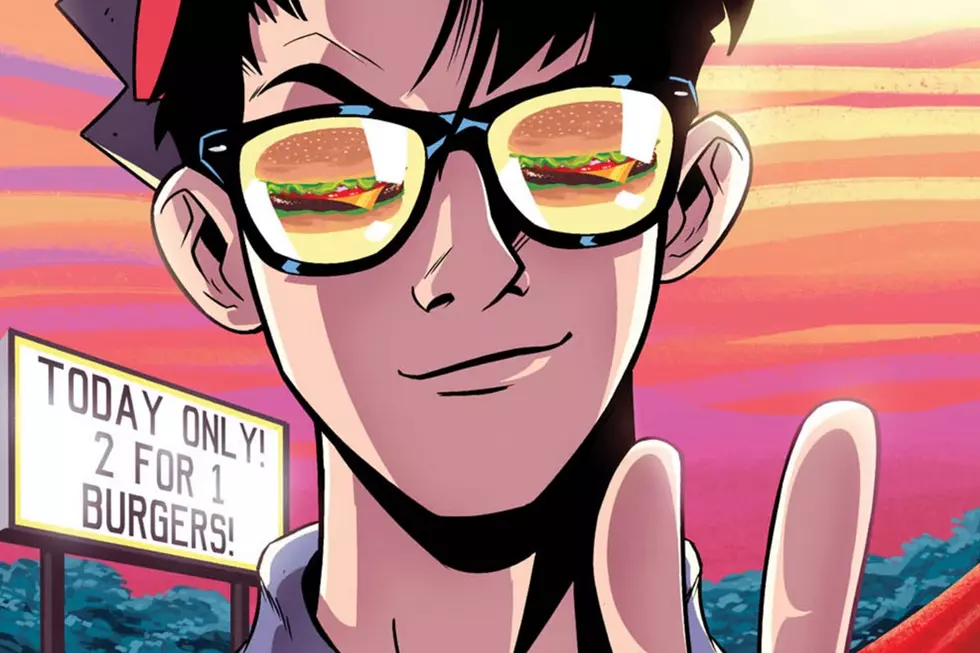
Cameron Stewart & Karl Kerschl Fuse Their Art into a Hybrid Style in ‘Assassin’s Creed: The Fall’

Comics are a collaborative medium, and there's nothing quite like seeing fantastic creators team-up to make something new from the sum of their talents. When a powerhouse writer and a powerhouse artist -- like Grant Morrison and Frank Quitely, or Alan Moore and J.H. Williams III -- get together, people tend to expect big things. A slightly different situation is when an artist collaborates with another artist; sometimes one will ink the other's pencils, provide layouts, or even trade off doing entire pages.
What's more rare is what Cameron Stewart and Karl Kerschl did in the DC Comics book Assassin's Creed: The Fall, with the assistance of color art from Nadine Thomas: The two artists took their two styles and blended them into something entirely new.

Stewart and Kerschl truly collaborated on the pages, trading penciling, inking, and (presumably) layout duties over the course of the series. The result is a book that doesn't look like what you'd expect a Cameron Stewart or Karl Kerschl comic to look at, but still retains enough familiarity to indicate the handiwork of each of them.

Karl Kerschl's style -- or the style that I'm most familiar with -- is by far the more cartoony of the two. Kerschl's work wouldn't be out of place on a Saturday morning cartoon, or at the forefront of a big animated feature film. His characters tend to run skinny, but fit, and his faces warp under the pressure of the emotions they're conveying. Kerschl is expressive, and distorts anatomy to better serve the personality of the characters he's depicting.

Cameron Stewart's art is less cartoony, but still in the lane of artists like Mike Allred or Darwyn Cooke. He approaches realism in the proportion of his figures, but doesn't fully embrace it, like Bryan Hitch or Frank Quitely would. Instead, he gets just close enough to let your mind fill in the blanks, and he does it by layering on the little details. Stewart pops realistic clothing, believable facial expressions, haircuts people would actually have in real life, and fashion accessories into his art. It all clicks really well in the end, and Stewart's style is really a sublime mix of cartooning and realism.


On The Fall, these two men managed to combine their styles into something that was, if not greater than the sum of its parts, at least as good and entirely new. While reading, I couldn't help but try to figure out who did what. Stewart draws extraordinarily cute women, so my first thought was that all of the women must be his work. On closer examination, though, I could never say for sure. Occasionally there would be cheekbones, lips, or eyes that reminded me of his past work, but there was always something just a little bit off -- maybe the hair wasn't really in Stewart's style, or the structure of her face was a little too cartoony.

The lines between Kerschl and Stewart blur even more during the fight scenes. The deft choreography Stewart displayed in his run on Batman & Robin blends with Kerschl's flawlessly kinetic action, and is layered with Stewart's ability to lend his characters true weight, which in turn is combined with Kerschl's ability to showing us exactly what we need to see during a fight, even if it doesn't quite make sense at first glance.

Trying to deconstruct Kerschl and Stewart's hybrid work is like trying to figure out one of MC Escher's paintings. All of it wraps back in on itself, each part references another part, and actually pulling it apart to see how it works is essentially impossible. This is a good thing, mind you -- it adds another layer onto the experience of reading a comic, something akin to solving a puzzle or aggressively interrogating a work of art to see why it works so well. It almost forces you to take a closer look, just because the experience is so different from what you'd expect.

On top of the art fusion Stewart and Kerschl displayed here, they also cowrote the story, which is a tie-in to a popular and history-bending video game. The fact that they found space to experiment and evolve their own styles on what's generally the most corporate of comics projects. They proved that, together or apart, they are forces to be reckoned with. You should get familiar with them.
Here's a video from our prior coverage of Assassin's Creed: The Fall.
More From ComicsAlliance









